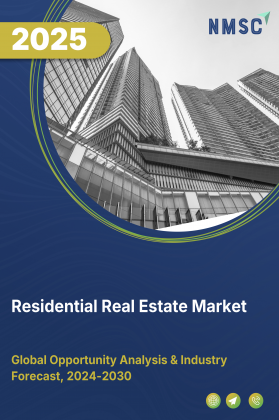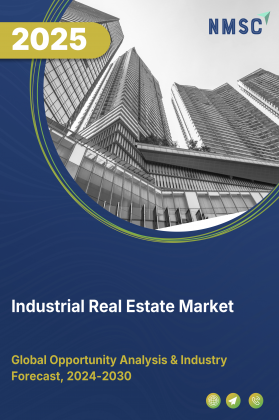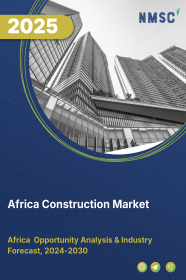
Residential Real Estate Market by Property Type (Villas, Semi-detached, Townhouse, and Others), by Size (Small: <500 sq. ft., Medium: 500–2000 sq. ft., Large: 2000+ sq. ft.), by Revenue Model (Ownership, Primary and Secondary, Rental, Purpose-built, Private, and Short-stay), by Sales Channel (Direct Developer, Brokers, Online Platforms), by Price Tier (Affordable, Mid-market, Luxury), and by End-User (First-time Homebuyers) – Global Opportunity Analysis and Industry Forecast 2025-2030.
Industry Outlook
The global Residential Real Estate Market size was valued at USD 12.55 trillion in 2024, with an estimation of USD 13.76 trillion in 2025 and is predicted to reach USD 21.76 trillion by 2030 with a CAGR of 9.6% from 2025-2030. The market is experiencing robust growth driven by rapid urbanization, rising disposable incomes, and technological advancements.
Increasing migration to urban areas fuels demand for housing, prompting developers to build modern apartments, gated communities, and mixed-use projects. Higher disposable incomes enable buyers to invest in premium properties and lifestyle-focused homes, while smart home integration enhances convenience, efficiency, and property value.
Simultaneously, rising property prices pose affordability challenges, particularly for first-time buyers, limiting the residential real estate market expansion. To address this, rental and co-living solutions are gaining traction, offering flexible, cost-effective living options for young professionals and students, creating new opportunities and sustaining long-term growth in the sector.
Rapid Urbanization Drives the Market Growth
Rapid urbanization significantly drives the residential real estate market growth. As more people migrate from rural to urban areas in search of employment, education, and better living standards, the demand for housing in cities rises sharply. This influx creates pressure on existing residential infrastructure, prompting developers to construct new apartments, gated communities, and mixed-use housing projects.
Urbanization also encourages the development of modern amenities, improved connectivity, and lifestyle-focused residential solutions, making urban housing more attractive. Consequently, cities experiencing high urban population growth witness robust activity and investment in the sector.
Rising Disposable Income Fuels Market Expansion
Increasing disposable income among individuals and households is a key driver of the residential real estate market demand. As people have more money to spend after meeting their essential expenses, they are more likely to invest in purchasing homes, upgrading to larger or better-quality properties, or exploring premium residential options.
Higher disposable income also supports demand for modern amenities, gated communities, and lifestyle-focused housing projects. This trend encourages developers to introduce diverse residential offerings and contributes to overall market growth, particularly in urban and semi-urban areas where income levels are rising steadily.
Technological Innovation and Smart Home Integration Boosts Market Demand
Advancements in technology and the growing adoption of smart home solutions are driving demand in the market. Homebuyers increasingly seek properties equipped with automated lighting, climate control, security systems, and energy management tools. Developers are responding by incorporating these features into new projects, enhancing convenience, efficiency, and sustainability. This trend not only differentiates residential offerings but also attracts tech-savvy buyers, strengthens property values, and supports long-term growth in a competitive real estate market.
Rising Property Prices Limits the Market Growth
As property prices increase, affordability becomes a major challenge for potential homebuyers, especially first-time buyers or middle-income groups. High costs limit the number of people able to invest in residential properties, slowing down sales growth and reducing demand. This restraint is exacerbated by inflation, rising construction costs, and limited availability of land in urban areas, making it harder for developers to offer affordable housing options.
Rental and Co-Living Solutions Unlocks New Growth Opportunities for the Market
Rental and co-living solutions a key growth opportunity for the residential real estate sector, the growing preference for flexible and affordable living arrangements is being fuelled by rising property prices, rapid urban migration, and evolving lifestyle choices, especially among young professionals, students, and mobile workers.
Developers and investors leverage this trend by offering thoughtfully designed rental apartments or co-living communities with modern amenities, shared spaces, and convenient services. This strategy not only provides a reliable rental income stream but also captures a large and expanding market segment, driving sustained growth in the residential real estate sector.
Market Segmentation and Scope of the Study
The residential real estate market report is segmented on the basis of property type, size, revenue model, sales channel, price tier, end-user and region. By property type, the market is categorized into villas, semi-detached homes, townhouses, multifamily apartments and condominiums, cooperative housing, modular units, plotted developments, apartments/flats, single-family homes, vacation homes, and others. By size, properties are classified as small (<500 sq. ft.), medium (500–2000 sq. ft.), and large (2000+ sq. ft.). By revenue model, the market is divided into ownership, including primary and secondary segments, and rental, comprising purpose-built rental, private, and short-stay segments. Sales channels include direct developer, brokers, and online platforms. Price tiers are segmented into affordable, mid-market, luxury, and ultra-luxury, while end-users comprise first-time homebuyers, repeat buyers, luxury buyers, and seniors/retirees. Regional analysis covers Asia-Pacific, North America, Europe, and RoW.
Geographical Analysis
Population growth and urbanization are significant drivers of the residential real estate market share in North America. According to the World Bank, in 2024, 84% of the U.S. population lives in urban areas, highlighting the high concentration of people in cities. This urbanization increases demand for housing near employment hubs, schools, and amenities, stimulating new residential construction and property development. The dense urban population also puts upward pressure on home prices and encourages the expansion of infrastructure and services, further supporting the growth of the market across North America.
Economic growth and rising household incomes are important drivers of the market in Europe. As European economies expand and employment levels rise, households gain greater disposable income, increasing their ability to purchase or invest in homes. Strong economic conditions also boost consumer confidence, encouraging more people to participate in the housing market. This combination of higher affordability and confidence stimulates demand for residential properties, supports new construction projects, and contributes to rising property values across Europe.
Governments across Asia-Pacific introduce measures to make homeownership more accessible and to stimulate the housing sector. These include tax rebates for homebuyers, subsidized mortgage schemes, relaxed lending norms, and dedicated programs for first-time buyers.
Additionally, large-scale urban development initiatives and affordable housing projects aim to meet the growing demand in rapidly expanding cities. Such policies not only encourage more people to enter the housing market but also boost construction activity and attract investment, collectively driving sustained growth in the residential real estate industry, throughout the Asia-Pacific region.
Expansion of transportation networks, utilities, and social amenities—such as roads, metro lines, schools, and hospitals, enhances the attractiveness of residential areas in the Rest of the World. Improved infrastructure increases accessibility and livability, leading to higher demand for housing in well-connected locations. This, in turn, encourages property development, stimulates construction activity, and drives up property values, making infrastructure development a key factor supporting growth in the market in the Rest of the World (RoW).
Strategic Innovations Adopted by Key Players
Key players in the residential real estate industry are accelerating global expansion through upscale brand launches, service diversification, and strategic partnerships.
-
In September 2024, Barratt Developments has entered a joint venture with Homes England and Lloyds Banking Group to develop large-scale residential sites, targeting the national housing shortage and streamlining the development process. The initiative aims to accelerate the construction of new homes while enhancing infrastructure planning across key regions.
-
In February 2024, PulteGroup, a leading U.S. homebuilder, has announced a strategic partnership with SPAN to integrate advanced energy management solutions into its residential developments. The collaboration will equip new homes with cutting-edge EV-charging capabilities and comprehensive energy monitoring systems, enabling homeowners to reduce utility costs while supporting sustainable living. Industry experts view this move as a significant step in aligning residential real estate offerings with growing consumer demand for energy-efficient and technology-enabled homes, strengthening PulteGroup’s competitive position in the market.
Key Benefits
-
The report provides quantitative analysis and estimations of the industry from 2025 to 2030, that assists in identifying the prevailing residential real estate market opportunities.
-
The study comprises a deep-dive analysis of the current and future residential real estate market trends to depict prevalent investment pockets in the sector.
-
Information related to key drivers, restraints, and opportunities and their impact on the market is provided in the report.
-
Competitive analysis of the key players, along with their market share is provided in the report.
-
SWOT analysis and Porters Five Forces model is elaborated in the residential real estate market study.
-
Value chain analysis in the market study provides a clear picture of roles of stakeholders
Residential Real Estate Market Key Segments
By Property type
-
Villas
-
Semi-detached
-
Townhouse
-
Multifamily apartments & condominiums
-
Cooperative housing
-
modular
-
Plotted
-
Apartments / Flats
-
Single-Family Homes
-
Vacation Homes
-
Condominiums
-
Others
By Size
-
Small (<500 sq. ft.)
-
Medium (500–2000 sq. ft.)
-
Large (2000+ sq. ft.)
By Revenue Model
-
Ownership
-
Primary
-
Secondary
-
Rental
-
Purpose-built rental
-
Private
-
Short-stay
By Sales Channel
-
Direct developer
-
Brokers
-
Online platforms
By Price
-
Affordable
-
Mid-market
-
Luxury
-
Ultra-luxury
By End-User
-
First-time Homebuyers
-
Repeat Buyers
-
Luxury Buyers
-
Seniors/Retirees
By Region
-
North America
-
The U.S
-
Canada
-
Mexico
-
-
Europe
-
The UK
-
Germany
-
France
-
Italy
-
Spain
-
Denmark
-
Netherlands
-
Finland
-
Sweden
-
Norway
-
Russia
-
Rest of Europe
-
-
Asia-Pacific
-
China
-
Japan
-
India
-
South Korea
-
Australia
-
Indonesia
-
Singapore
-
Taiwan
-
Thailand
-
Rest of Asia-Pacific
-
-
Rest of the World
-
Latin America
-
Middle East
-
Africa
-
Key Players
-
D.R. Horton, Inc.
-
Lennar Corporation
-
China Vanke Co., Ltd.
-
PulteGroup, Inc.
-
Vonovia SE
-
Sekisui House, Ltd.
-
Daiwa House Industry Co., Ltd.
-
Equity Residential
-
MAA
-
Invitation Homes Inc.
-
American Homes 4 Rent
-
Barratt Developments plc
-
Berkeley Group Holdings plc
Report Scope And Segmentation
|
Parameters |
Details |
|
Market Size in 2025 |
USD 13.76 Trillion |
|
Revenue Forecast in 2030 |
USD 21.76 Trillion |
|
Growth Rate |
CAGR of 9.6% from 2025 to 2030 |
|
Analysis Period |
2024–2030 |
|
Base Year Considered |
2024 |
|
Forecast Period |
2025–2030 |
|
Market Size Estimation |
Billion (USD) |
|
Growth Factors |
|
|
Countries Covered |
28 |
|
Companies Profiled |
15 |
|
Market Share |
Available for 10 companies |
|
Customization Scope |
Free customization (equivalent to up to 80 working hours of analysts) after purchase. Addition or alteration to country, regional, and segment scope. |
|
Pricing and Purchase Options |
Avail customized purchase options to meet your exact research needs. |















 Speak to Our Analyst
Speak to Our Analyst























